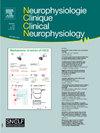Intraoperative recordings from the posterior superior insula in awake humans with peripheral neuropathic pain
IF 2.4
4区 医学
Q2 CLINICAL NEUROLOGY
Neurophysiologie Clinique/Clinical Neurophysiology
Pub Date : 2025-01-30
DOI:10.1016/j.neucli.2025.103056
引用次数: 0
Abstract
Background and Objectives
The activity profile of the posterior insula in neuropathic pain (NeP) remains largely unexplored. To address this and examine its modulation by somatosensory stimulation, we recorded local field potentials (LFP) in awake patients with NeP undergoing deep brain stimulation (DBS) electrode implantation to the posterior-superior insula (PSI) for analgesic purposes.
Materials and Methods
Six patients (one woman; 32–45 years), experiencing refractory peripheral NeP and having previously responded to non-invasive stimulation of the PSI underwent stereotactic implantation of DBS electrodes to the PSI as part of a phase II clinical trial. The averaged power of frequencies of LFP and their peaks were calculated during rest and under thermal painful and mechanical non-painful stimulation.
Results
At rest, amplitude peaks within the delta (average min-max.: 2.2 Hz; 1.3–3.7) and theta (6.1 Hz, varying between 5.7 and 6.8 Hz) bands were identified. Compared to rest, both tonic thermal painful, and mechanical non-painful stimulation led to similar mean decreases in gamma power (-24.46 ± 70.56, and -19.56 ± 3.08; respectively). Painful stimuli caused an increase in all the other frequency bands, mainly in alpha and beta ranges, while non-painful stimulation led to decreases in power in all frequencies above 4Hz. Painful tonic stimulation was associated with a significantly greater power variability, both in amplitude and frequency, compared to nonpainful mechanical stimulation.
Conclusion
The posterior insula resting state activity in awake patients with chronic NeP was characterized by predominant theta oscillations. Painful and innocuous stimulation led to opposite spectral changes, with a much larger variability across the whole frequency spectrum for painful stimuli, relative to both resting state and non-painful stimulation.
清醒的周围神经性疼痛患者术中脑岛后上的记录。
背景和目的:在神经性疼痛(NeP)中,脑岛后叶的活动特征在很大程度上仍未被探索。为了解决这一问题,并检查其通过体感觉刺激的调节,我们记录了清醒的NeP患者在脑深部刺激(DBS)电极植入后上岛(PSI)镇痛时的局部场电位(LFP)。材料与方法:6例患者(女性1例;32-45岁),经历难治性外周NeP并且之前对PSI的非侵入性刺激有反应,作为II期临床试验的一部分,将DBS电极立体定向植入PSI。计算静息、热痛和机械非痛刺激下LFP频率的平均功率及其峰值。结果:静息时,振幅峰值在δ(平均min-max)范围内。: 2.2 Hz;确定了1.3-3.7)和theta (6.1 Hz,在5.7和6.8 Hz之间变化)波段。与休息相比,强直性热痛和机械性无痛刺激导致的伽马功率平均下降相似(-24.46±70.56,-19.56±3.08);分别)。疼痛刺激导致所有其他频段的功率增加,主要是在α和β范围内,而非疼痛刺激导致4Hz以上所有频率的功率下降。与非疼痛性机械刺激相比,疼痛性强直性刺激在振幅和频率上都与更大的功率变异性相关。结论:清醒状态下慢性NeP患者脑岛后部静息状态活动以θ波振荡为主。疼痛刺激和无害刺激导致相反的频谱变化,相对于静息状态和非疼痛刺激,疼痛刺激在整个频谱上的可变性要大得多。
本文章由计算机程序翻译,如有差异,请以英文原文为准。
求助全文
约1分钟内获得全文
求助全文
来源期刊
CiteScore
5.20
自引率
3.30%
发文量
55
审稿时长
60 days
期刊介绍:
Neurophysiologie Clinique / Clinical Neurophysiology (NCCN) is the official organ of the French Society of Clinical Neurophysiology (SNCLF). This journal is published 6 times a year, and is aimed at an international readership, with articles written in English. These can take the form of original research papers, comprehensive review articles, viewpoints, short communications, technical notes, editorials or letters to the Editor. The theme is the neurophysiological investigation of central or peripheral nervous system or muscle in healthy humans or patients. The journal focuses on key areas of clinical neurophysiology: electro- or magneto-encephalography, evoked potentials of all modalities, electroneuromyography, sleep, pain, posture, balance, motor control, autonomic nervous system, cognition, invasive and non-invasive neuromodulation, signal processing, bio-engineering, functional imaging.

 求助内容:
求助内容: 应助结果提醒方式:
应助结果提醒方式:


